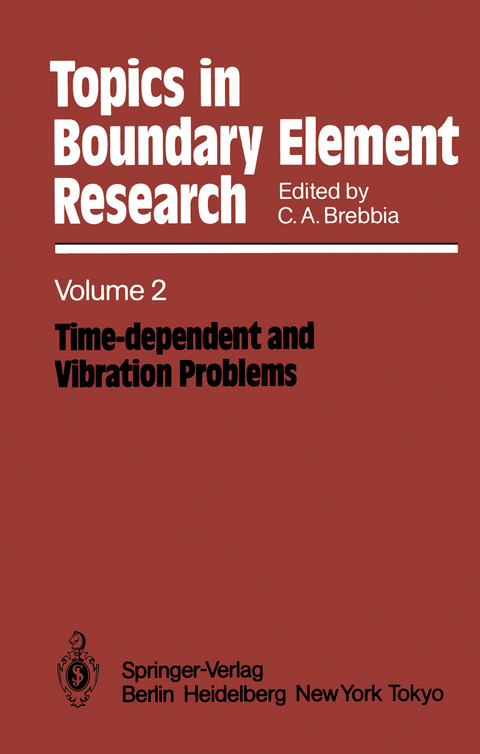
Time-dependent and Vibration Problems
Springer Berlin (Verlag)
978-3-642-82400-5 (ISBN)
1 Fundamentals of Boundary Integral Equation Methods in Elastodynamics.- 1.1 Introduction.- 1.2 Elastodynamic Problems.- 1.3 BIE Formulations in Time-Space Domain.- 1.4 BIE Formulations in the Transformed Domain of Integral Transforms.- 1.5 Integral Equation Formulations for Inhomogeneous Domain.- 1.6 Eigenfrequency Problems.- 1.7 Some Remarks on Inherent Problems of BIEM in Elastodynamics.- 1.8 Application Examples.- 1.9 Concluding Remarks.- References.- 2 Elastic Potentials in BIE Formulations.- 2.1 Introduction.- 2.2 Elastodynamic Formulations.- 2.3 Elastostatic Formulations.- 2.4 Solution Methods.- 2.5 Comments and Suggestions.- References.- 3 Time Dependent Non-Linear Potential Problems.- 3.1 Introduction.- 3.2 Governing Equations.- 3.3 Homogeneous Parabolic Equation.- 3.4 Constant and Linear Time Interpolation.- 3.5 Non-Linear Boundary Conditions for the Case of Constant Conductivity.- 3.6 Non-Linear Boundary Conditions for the Case of Temperature Dependent Conductivity.- 3.7 Applications.- 3.8 Conclusions.- References.- 4 Further Developments on the Solution of the Transient Scalar Wave Equation.- 4.1 Introduction.- 4.2 The Boundary Initial Value Problem.- 4.3 Dirac Delta and Heaviside Functions.- 4.4 Fundamental Solution in Three Dimensions.- 4.5 Kirchhoff Integral Representation.- 4.6 Two-Dimensional Boundary Integral Equation.- 4.7 Additional Transformations to Volterra's Integral Representation.- 4.8 Numerical Implementation.- 4.9 Examples.- References.- 5 Transient Elastodynamics.- 5.1 Introduction.- 5.2 Basic Theory.- 5.3 The Initial Value Problem of Elastodynamics.- 5.4 One-Dimensional Motions.- 5.5 Plane Motions.- 5.6 Fundamental Solutions for Transient Elastodynamics.- 5.7 Time Domain Elastodynamic Boundary Integral Representation.- 5.8 AdditionalTransformations to the Two-Dimensional Boundary Integral Equation of Elastodynamics.- 5.9 Numerical Implementation for Two Dimensions.- 5.10 Examples-Two-Dimensional Elastodynamics.- 5.11 Conclusions.- References.- 6 Propagation of Surface Waves.- 6.1 Introduction.- 6.2 Three-Dimensional Formulation.- 6.3 Floating Bodies.- 6.4 Vertical Axisymmetric Bodies.- 6.5 Vertical Cylinders of Arbitrary Section.- 6.6 Horizontal Cyclinders of Arbitrary Section.- 6.7 Transient Problems.- 6.8 Nonlinear Problems.- References.- 7 Boundary Integral Formulation of Mass Matrices for Dynamic Analysis.- 7.1 Introduction.- 7.2 Formulation of the Dynamical Problem.- 7.3 Various Boundary Integral Formulations.- 7.4 Boundary Integral Formulation Using the Statical Fundamental Solution.- 7.5 The Numerical Solution Procedure.- 7.6 Derivation of Different Types of Dynamical Problems.- 7.7 Two-Dimensional Formulation.- 7.8 Computer Implementation.- 7.9 Applications.- Conclusions.- References.- 8 Boundary Element Method for Laminar Viscous Flow and Convective Diffusion Problems.- 8.1 Introduction.- 8.2 Governing Equations.- 8.3 Boundary Integral Equations.- 8.4 Boundary Element Approximation.- 8.5 Computational Scheme.- 8.6 Numerical Examples.- 8.7 Conclusion.- References.- 9 Asymptotic Accuracy and Convergence for Point Collocation Methods.- 9.1 Introduction.- 9.2 Examples of Boundary Integral Equations.- 9.3 Standard Collocation for Two-Dimensional Problems.- 9.4 Standard Collocation for Three-Dimensional Problems with Fredholm Boundary Integral Equations of the Second Kind.- References.
| Erscheint lt. Verlag | 8.12.2011 |
|---|---|
| Reihe/Serie | Topics in Boundary Element Research |
| Zusatzinfo | XIV, 262 p. |
| Verlagsort | Berlin |
| Sprache | englisch |
| Maße | 156 x 244 mm |
| Gewicht | 447 g |
| Themenwelt | Mathematik / Informatik ► Mathematik ► Angewandte Mathematik |
| Naturwissenschaften ► Physik / Astronomie ► Mechanik | |
| Technik | |
| Schlagworte | Calculus • Dynamics • Elastostatics • Fourier transform • integral equation • Oscillation • Schwingung • statics • Time • Transformation • Vibration • wave equation |
| ISBN-10 | 3-642-82400-5 / 3642824005 |
| ISBN-13 | 978-3-642-82400-5 / 9783642824005 |
| Zustand | Neuware |
| Haben Sie eine Frage zum Produkt? |
aus dem Bereich


